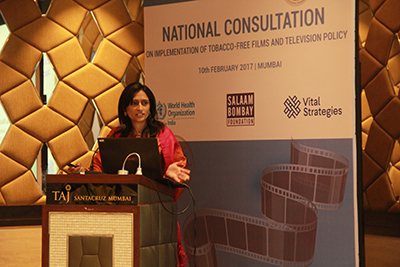By Pallavi Puri, Vital Strategies Communications Assistant – India
Nothing binds an Indian family like a television set and films in theatres. Be it our men in blue at the crease, Ekta Kapoor’s newest soap ruling the ratings charts, or the latest Khan’s blockbuster.
Do you ever wonder, what is the average time people spend watching TV daily in India?
BARC India’s latest report found that all India average time spent on television is 3 hours.
Moreover, India is home to the largest film industry in the world. The film industry in Mumbai alone produces over 900 movies per year (WHO, 2003). Mainstream Indian films are watched by an estimated 250 million young adults in India and have a large following overseas.
Studies have shown that tobacco use is normalized and perpetuated by its positive portrayals in films and television content (Sargent, 2005). Research in India has found that media advertising is associated with higher smoking rates (Arora et. al., 2008) and exposure to cigarette brand names or actors smoking on television is related to increased smoking among youth in India (Shah et. al., 2008). The size and popularity of the film and television industry has the power to influence the behavior and attitudes of millions of people in India and around the world (WHO, 2003).
Fortunately, policies that ban the advertising, promotion and sponsorship of tobacco, and the placement of anti-tobacco mass media messages that portray the truth about the deadly health harms of tobacco, have been found to be effective in countering pro-tobacco imagery and reducing tobacco consumption (Shah et. al., 2008; Gupta et. al., 1986).
The Government of India, recognizing the harm effects of tobacco, enacted a comprehensive legislation, the Cigarette and Other Tobacco Products (Prohibition of Advertisement and Regulation of Trade and Commerce, Production, Supply and Distribution) Act in 2003, under which the ‘Film Rule Policy’ was enacted in 2012. The Film Rule mandates the screening of pre-approved anti-tobacco ads and a disclaimer in the beginning and middle of the films and television programs that depict tobacco consumption; and static health warning messages on screen while the tobacco use is depicted.
To gauge the implementation of the various components of the Film Rule in film theatres and on TV, and to identify opportunities for strengthening the film rule, Vital Strategies in India, in collaboration with Ministry Of Health and Family Welfare (MOHFW) and WHO-India, at a high-level consultation on 10th February 2017 in Mumbai, launched the Highlights of the Study – “Evaluation of the Implementation of the Tobacco-free Film and Television Rules in India” and the recommendations that emerged from the study were shared and discussed with stakeholders. The consultation witnissed a multi-sectoral discussion where points were kept forward by tobacco victims, doctors, senior officials from MOHFW, Chairperson of the Ministry of Information and Broadcasting, the Central Board for Film Certification (including regional CBFC Boards) and other key stakeholders from the film fraternity, producers’ guild, TV channels. Additionally, tobacco control staff, advocates and BI partners and NGOs attended the consultation.
 Dr. Nandita Murukutla, Country Director, India, Vital Strategies at the launch of the ‘Evaluation of the Implementation of the Tobacco-free Film and Television Rules in India’ report
Dr. Nandita Murukutla, Country Director, India, Vital Strategies at the launch of the ‘Evaluation of the Implementation of the Tobacco-free Film and Television Rules in India’ report
The launch of the study has also been supported through strategic PR and earned media activities as well as a #ReelVsReal social media campaign, which talks about the disparity between the glamorous depiction of tobacco on reel and the fate of tobacco victims in real life. Read the findings of the study here and stay tuned to updates in India at www.tobaccokills.co.in